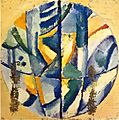Olga Rozanova facts for kids
Quick facts for kids
Olga Rozanova
|
|
|---|---|

Rozanova in 1900
|
|
| Born |
Olga Vladimirovna Rozanova
July 22, 1886 Melenki, near Vladimir Oblast, Russia
|
| Died | November 7, 1918 (aged 32) Moscow, Russia
|
| Movement | Cubo-Futurism, Suprematism |
Olga Vladimirovna Rozanova (born June 22, 1886 – died November 7, 1918) was a talented Russian artist. She was part of the "avant-garde" movement, which means she created new and experimental art. Olga painted in styles like Suprematism, Neo-Primitivism, and Cubo-Futurism. These art styles focused on new ways to show feelings and ideas, often using bright colors and geometric shapes.
Contents
About Olga Rozanova's Life
Her Early Years
Olga Rozanova was born in a small town called Melenki, near Vladimir. Her father, Vladimir Rozanov, was a police officer. Her mother, Elizaveta Rozanova, was the daughter of an Orthodox priest. Olga was the fifth child in her family. She had two sisters, Anna and Alevtina, and two brothers, Anatolii and Vladimir. Olga's father passed away in 1903. After that, her mother became the head of their home.
Olga finished school at the Vladimir Women's Gymnasium in 1904. She was very interested in new art ideas. Because of this, she moved to Moscow to study painting.
Her Artistic Journey
When Olga arrived in Moscow, she went to the Bolshakov Art School. There, she learned from artists like Nikolai Ulyanov. In 1907, she tried to get into the Stroganov School of Applied Art but was not accepted. So, she trained in the private studio of Konstantin Yuon. From 1907 to 1910, other students in these studios included Lyubov Popova and Nadezhda Udaltsova. Unlike many other female artists of her time, Olga Rozanova did not travel abroad to study European art.
By 1910, Olga was becoming well-known in Russian art groups. She moved to St. Petersburg and joined a group called Soyuz Molodyozhi (Union of Youth) in 1911. She was a very active member of this group. They organized art shows, talks, and discussions. Two of her paintings, Nature-morte and The Café, were shown at the second Soyuz Molodyozhi exhibition in April 1911. She continued to show her art with this group until 1913.
In January 1912, her works Portrait and Still-Life were shown at another Soyuz Molodyozhi exhibition. This show also featured the Donkey's Tail, an art group from Moscow. Olga traveled to Moscow to try and create joint projects between the two groups. However, these talks were not successful. The Soyuz Molodyozhi group ended in 1914.
From 1913 to 1914, Olga's art started to show ideas from Cubo-Futurism. She was especially inspired by the Italian art movement called Futurism. Of all the Russian Cubo-Futurists, Olga's work was most like the ideas of Italian Futurism. When the founder of Futurism, Filippo Tommaso Marinetti, visited Russia in 1914, he was very impressed by her art. Olga later showed four of her works in the First Free International Futurist Exhibition in Rome in 1914.
Olga met the poet Aleksei Kruchyonykh in 1912. He introduced her to a Russian Futurist idea called zaum poetry. This was a special kind of language with no fixed meanings. Olga wrote her own zaum poetry. She also drew pictures for books of zaum poetry, like A Little Duck's Nest of Bad Words and Explodity (both from 1913). With Kruchenykh, she created a new type of Futurist book called the samopismo. In these books, the pictures and words were directly connected.
Olga joined the avant-garde group Supremus in 1915. This group was led by Kazimir Malevich, another artist she knew. By this time, her paintings had moved beyond Cubism and Futurism. She started creating pure abstract art. In this style, the artwork is organized by the visual weight and relationships of colors.
In the same year, she showed her art at the 0,10 Exhibition. She also worked with other Suprematist artists at the Verbovka Village Folk Centre.
From 1917 to 1918, Olga created a series of abstract paintings. She called these tsv'etopis, which means "color painting." Her painting Non-objective composition, 1918, also known as Green stripe, showed new ideas for using flat colors.
Olga also wrote essays about art. One essay was called The Bases of the New Creation and the Reasons Why it is Misunderstood. In this essay, she explained her ideas about modern art. She believed that the world is like a raw material for artists. She said that creating pictures based on "Abstract Principle" has three steps. These steps are intuition, changing what you see, and abstract creation.
Her Death and Lasting Impact
Olga Rozanova passed away from diphtheria in Moscow in 1918. She was only 32 years old. She caught a cold while preparing for the first anniversary of the October Revolution.
Today, her artworks are displayed in famous museums. These include the Museum of Modern Art, the Philadelphia Museum of Art, and the Harvard Art Museums. Her art continues to inspire people around the world.
Important Artworks
- In a Cafe (around 1911-1912) - This is one of Olga's earlier paintings. It shows a man and a woman sitting at a table. Olga used bright colors and thick lines. The painting mixes ideas from French avant-garde and Russian Neo-Primitivist art.
- The Factory and the Bridge (around 1913) - This painting was shown in the First Free International Futurist Exhibition in 1914. It was inspired by the Italian Futurism movement. Its bright colors give it an expressionist feel.
- Metronome (around 1914) - This artwork is from the middle of her career. Metronome was shown at the Last Futurist Exhibition 0,10 in 1915.
- Playing Cards series (1915) - This is one of her most famous works. It shows the peak of her artistic skill. The series includes portraits of her friends designed as playing cards.
Gallery
See also
 In Spanish: Olga Rozanova para niños
In Spanish: Olga Rozanova para niños


















